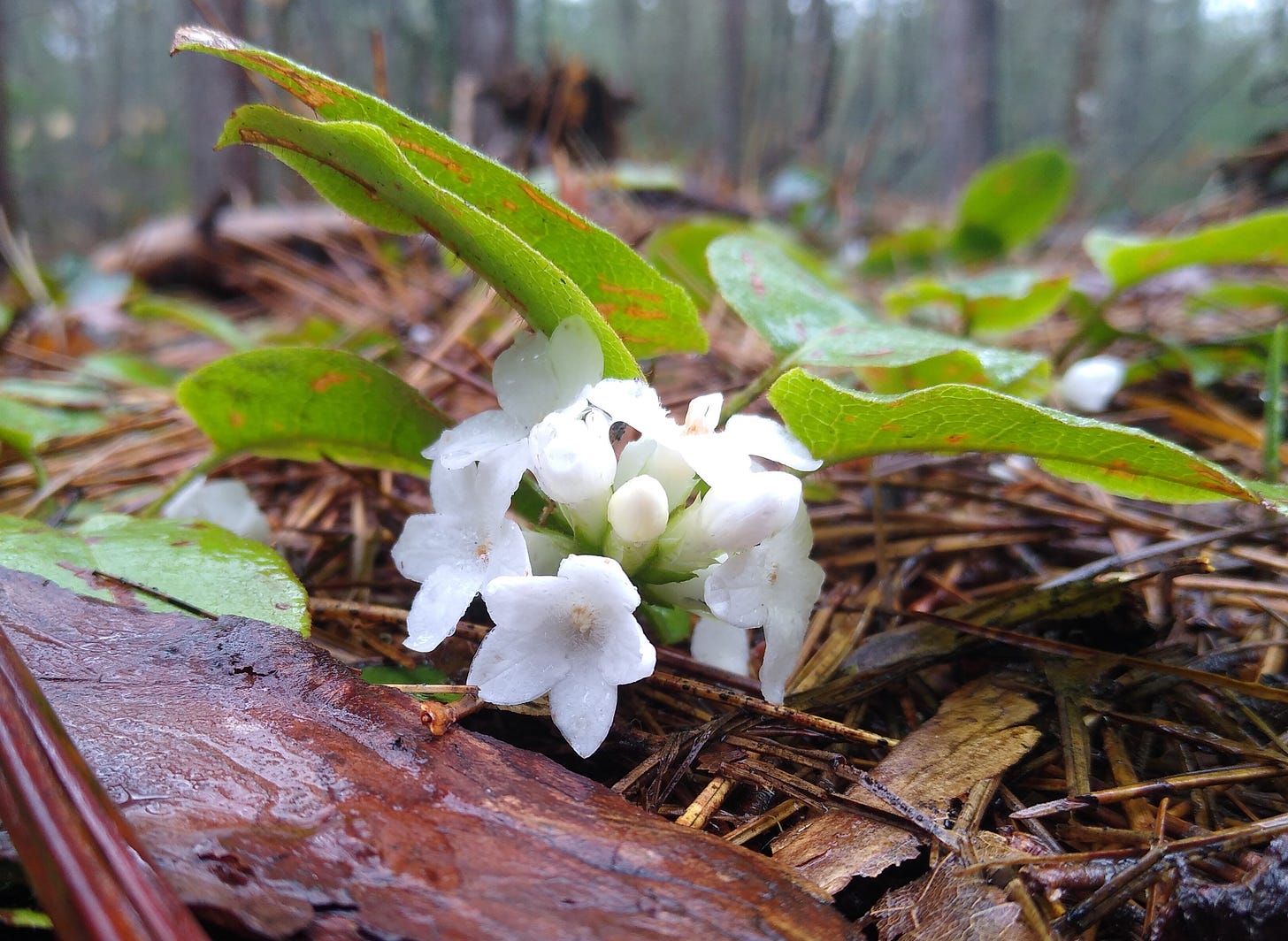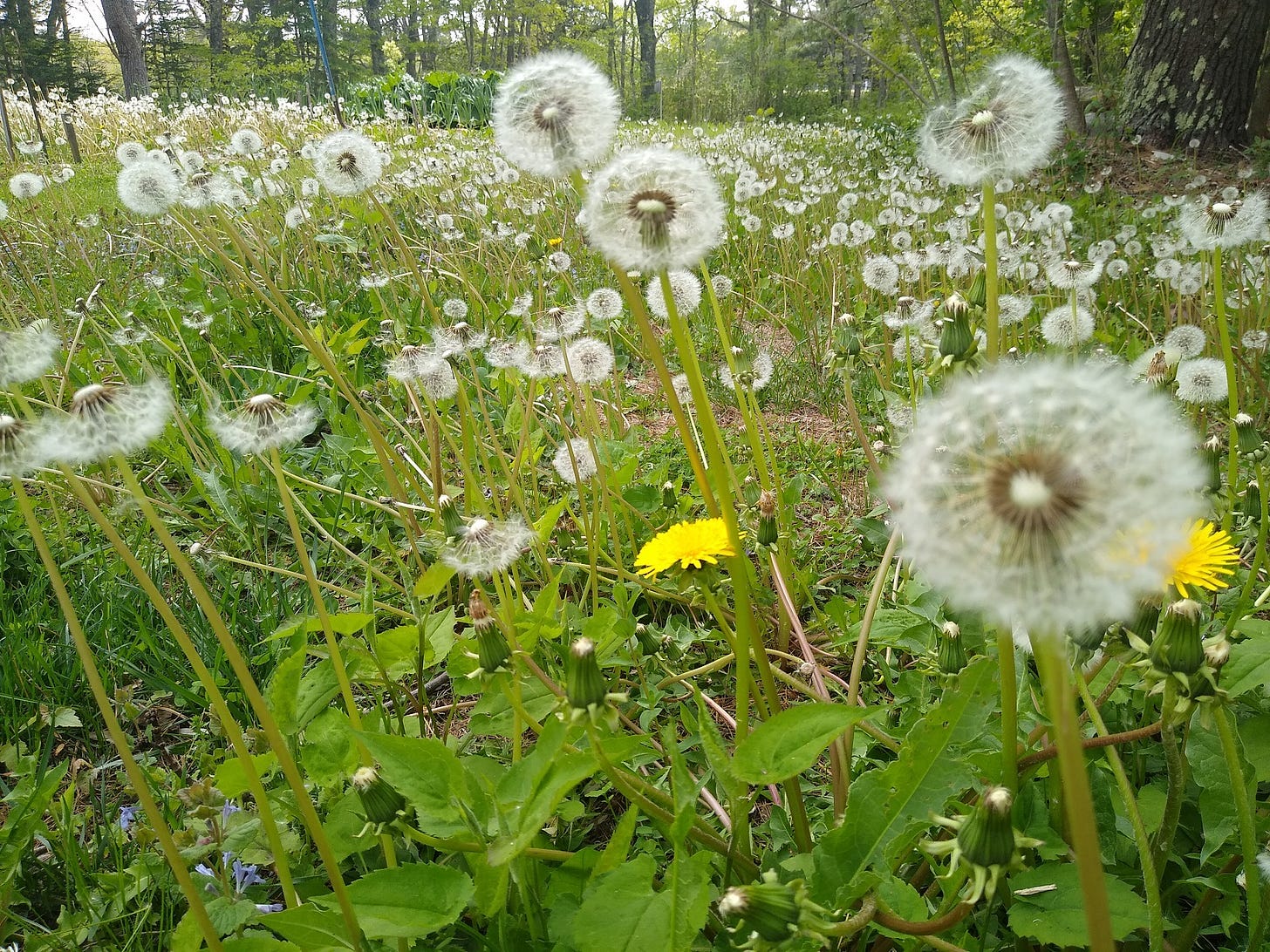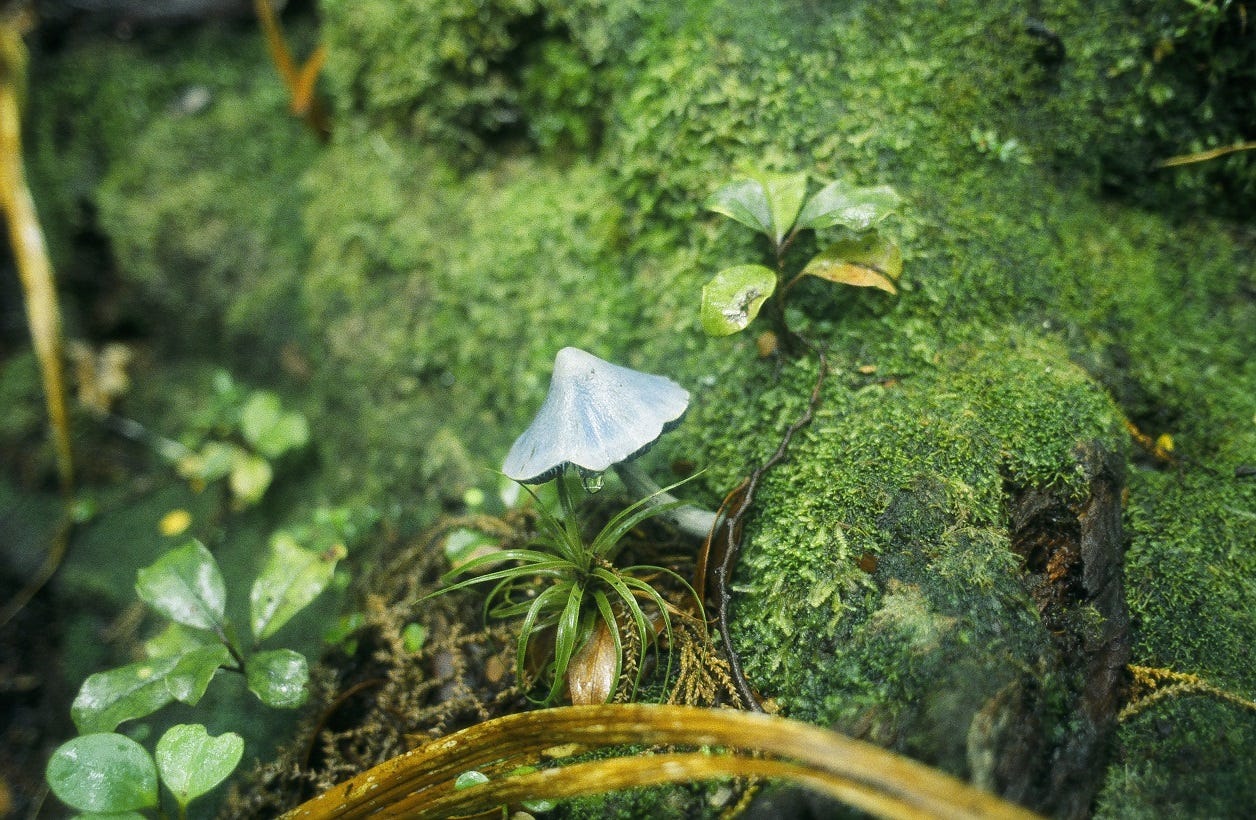The Beauty of Restraint
5/25/23 – Clean energy is only the beginning
Hello everyone:
Just before publishing tonight, I learned about a sudden push by the conservative Brazilian Congress to pass legislation that would gut both the environment and Indigenous ministries. If successful, Lula’s government might find it impossible to protect forests and indigenous lands from miners and loggers. Those are high stakes and terrible consequences at both a local and global scale. I don’t often push these things, and I don’t know if it will help, but you can add your name to a global petition by the powerful activist group Avaaz. Congress could vote in the next few days.
As always, please remember to scroll past the end of the essay to read some curated Anthropocene news.
Now on to this week’s writing:
One of my favorite uses of a verb in a poem is by the great Mary Oliver in her book American Primitive. She describes mushrooms “pummeling upward” through the soil, quiet fists breaking out of their shadow realm into ours. (For me, the “mm” sound of “pummel” always evokes the smooth, round emerging mushroom cap.) As with so much of Oliver’s writing, the poem begins with wonder and then explores the world as it is, dark and deep. Here she is astonished at the suddenness of the mushrooms’ appearance after a rain, and at the quietude of their presence.
“Mushrooms” is a fall poem, but I’ve been thinking this spring of that lovely tension between life’s irrepressible energy – its suddenness – and its quietude. Life has burst forth all around us, and spring is somehow already surging toward summer at what seems a dizzying speed.
Walking, as we do, from winter into spring on the trails and roads here in midcoast Maine, Heather and I eagerly awaited the first signs of skunk cabbage and wood frog but – just days later, it seems – find ourselves with lilac blooms on the dining table and cucumber seedlings blinking awake in the garden.
Spring ephemerals, like the trailing arbutus you see above, had their moment before fern fiddleheads and Canada mayflowers outnumbered them on the forest floor. Wood frogs croaked gently and briefly before falling silent as spring peepers reached their crescendo and American toads trilled their dissonant harmonies. Trees are blossoming and leafing out. Everyone is on a quest of some kind: turtles and salamanders for water, porcupines for dandelion greens or willow twigs (everything is delicious after a winter dining on spruce bark), and hermit thrushes for territory to claim.
As always, spring feels like a wild ruckus celebrating the explosion of life. It’s a crazy party. Everybody is advertising for sex. That’s the suddenness that Mary Oliver reminds us of. But there’s also the quietness, and that’s the lesson I have on my mind.
I don’t mean quietness as a function of sound, really, but as a modesty of presence. No one is trying to take over.
Pick any example I mention here – fern or thrush or frog – or one of ten thousand others in your part of the world, and measure it instead for its modesty of place and claim. Sure, the peepers are deafening, but each one is the size of a quarter and the species fades out of sight after mating season. Likewise, a spring ephemeral says Hello and then disappears, the earliest wallflowers at the party. Oyster and cinnamon ferns stick around all summer, but in modest numbers and quiet places.
Some species are busier, certainly. Hemlocks or oaks may dominate a forest canopy, but they’re more shepherds than autocrats, hosting complexity in their branches, on the ground, and among their roots. On the islands Heather and I frequent here, hay scented fern can form dense colonies that block other plants from growing, but this is a phase in forest growth rather than a permanent state. An abundance of wolves or deer will alter their community, but in a natural landscape such abundance phases in and out according to the tides of energy in the system.
There is something built into the fabric of life which places the highest value on modesty. I’m not talking about sexual modesty (witness the bright colors of baboon butts and peacock tails and lilac blossoms) but about how the push-and-pull of a living community requires that everyone live within limits. Even the amazing fecundity of a female oyster, for example, birthing perhaps 60 million eggs in a year, is a function of a system built for limits, in which nearly all those eggs end up as food for the oyster’s neighbors. Likewise, despite suburban protests, the billion dandelion seeds floating through the neighborhood are also modest, doomed to be mere stars amid the grassy universe.
Species grow, reproduce, and die amid a dense thicket of relationships that shape and constrain their capacity to crowd out each other. Call it competition (if you’re still stuck in a 20th century concept of the individual) or call it cooperation (if you’re a relentless optimist), but regardless it’s a community living by rules so ancient they might as well have been written by the Sun.
There are Ecology 101 topics within this that I could research and present here for you, but as you’ve already guessed I’m actually more interested in looking at who and where Anthropocene humans are on the map of the living world, and where we’re going next. Or rather, what we need to learn in order to make a better future for us and our living community.
The word I have in mind is restraint.
In fact, I’ve had the word in mind since my first Field Guide post, in which I honored my father and the great Barry Lopez, both of whom had recently died, as I introduced the concept of the Anthropocene. I quoted Lopez then (from Arctic Dreams), offering one of his gentle, elegant, sophisticated nuggets of wisdom on the conundrum of human choice amid our catastrophic actions. The bold emphasis is mine:
Because mankind can circumvent evolutionary law, it is incumbent upon him, say evolutionary biologists, to develop another law to abide by if he wishes to survive, to not outstrip his food base. He must learn restraint. He must derive some other, wiser way of behaving toward the land. He must be more attentive to the biological imperatives of the system of sun-driven protoplasm upon which he, too, is still dependent… Having taken on his own destiny, he must now think with critical intelligence about where to defer.
As happens so often while reading Lopez, I’m inspired by the beautiful clarity of his writing and heartsick at the likelihood of civilization attaining that clarity. But that’s the task before us. We have to acknowledge our physical limits and devise metaphysical laws to instruct us in the kind of modesty still inherent in every other species on Earth.
Or rather, we have to shoehorn the industrialized globe back into the kind of small-impact society that characterized human life for millennia. Indigenous folks still live that life, quietly protecting much of the land the rest of us have not yet damaged. They’ve done so even as, in mere decades, the rest of us have burned millions of years of stored fossil fuels to power our way into the delusion that despite the evidence all around us we somehow deserve another planet.
This question of energy is at the core of the restraint problem. For a century or two now, we've been pretending that we had unlimited energy to do with as we wished, and have acted as if there would be no meaningful consequences. The good news is that there’s an effort underway to replace fossil fuel energy sources with renewables. The bad news is that a) it’s too late to avoid at least some of those existential consequences, b) “clean” energy is not clean enough, and c) we seem intent on using these new energy sources to power a civilization that still devours and contaminates life on Earth.
Any discussion of restraint – in energy, consumption, or population – is still hard to find amid the glossy advertisements promising we can live exactly as we do now if only we replace our fossil fires with electric batteries.
The Intercept addresses this directly in a recent piece calling out the “electrify everything” movement’s consumption problem. The article cites a report, “Achieving Zero Emissions with More Mobility and Less Mining,” from the Climate and Community Project which found that huge reductions in mining for our “clean” future can be found simply by making EVs and their batteries smaller, by reducing our dependency on cars, and by building a robust recycling system. It cites also the IPCC report from last year on climate mitigation strategies, which for the first time had a chapter on the importance of decreasing demand for energy.
These are voices in the electric wilderness, though, as energy companies and large utilities fight tooth and nail to protect their interests, as car companies push high-profit SUVs over compacts, and as consumers wrestle with constant disinformation about the necessary joys of consumption.
I’m reminded of the Intercept piece I cited last week, “Addressing Climate Change Will Not ‘Save the Planet,’” in talking about how our blindness to the biodiversity crisis makes it more likely that at least some climate solutions will worsen rather than improve the problem. The author also makes a good point about restraint (bold emphasis is mine):
It may be that solving the climate crisis, because we will solve it with bold technologies to maintain ourselves in overshoot — as opposed to practicing humility and restraint with an eye toward contraction of the human enterprise — will accelerate extinctions, due to the demands for space and minerals to drive the technologies. To generate solar and wind power on the scale necessary to decarbonize the U.S. utility and transportation sectors, for example, requires land use on a massive scale.
For an infuriating follow-up to my writing last week on the problems with the solar revolution, check out the Guardian’s reporting on how that revolution is erasing massive swathes of desert habitat in the western U.S.. If we can clear-cut vibrant Maine forests without thinking of the costs to life, then in our ignorance of the fragile, quiet, and slow-moving desert ecosystems we can certainly bulldoze the Mojave.
It’s not just energy, of course. Like any assessment of the meaning of our own lives, it’s a question of where we put our energies. Articles popping up like mushrooms in my inbox this week provide plenty to think about in terms of restraint. Anthropocene, for example, cleverly addresses the quandary of artificial fertilizer use in the form of two opposing statements: “More (But Greener) Fertilizer Is The Way Forward” vs. “No. Less Fertilizer (And Less Meat) Is The Right Path.”
To complement the quandary, take a look at this quick summary of global meat consumption and its ties to population, food shortages, biodiversity loss, water and energy use, climate change, and more.
For a glimpse, in one image, of how unrestrained human population growth has been tightly woven into our habit of unrestrained use of synthetic fertilizer, take a look at the graphic above. More than half of humanity relies on this petroleum-derived product for their survival. Imagine, as you look at the graph, the impacts on the rest of life on Earth from that relationship between four billion people, artificial agriculture, and the unholy nexus of pollution, energy, and pesticides that make it happen.
Then decide for yourself whether we should be discussing how to ethically and responsibly shift civilization toward being restrained in size and scope by a new rule: No artificial fertilizer. That would, I think, fit under Barry Lopez’s notion of finding a “wiser way of behaving toward the land.”
On the climate front, take a look at Bill McKibben’s latest post from The Crucial Years, just out today, where in his plainspoken brilliance he offers opportunities to stop some really absurd examples of our vestigial obsession with constant growth in fossil fuel production and usage: private jetports and fracked-gas pipelines.
The opposite of restraint, in the Anthropocene, is the fatal fantasy of constant growth. Your life and mine, and the lives of most other species, have been defined by this absurd and dangerous notion that only by constantly growing can human society thrive. That’s how civilization became a machine. But by natural law, the possibility of constant growth does not exist on this finite planet, of which we are a part and by which we are absolutely constrained.
Constant growth is the logic of the cancer cell and yet somehow the bread-and-butter of deluded economists. Without the eradication of this “theory” from all levels of policy, any attempts to embed restraint into society will be piecemeal and small-scale. Please, every time you hear reports on economic growth – particularly concerns about a slow-down in growth – remind yourself that you’re listening to a society that’s being forced to mow down the natural world with the sophistication of a bulldozer and the logic of a junkie.
I wrote a three-part series a year and a half ago on the delusion of constant growth and how we mature away from it. You can start here with “An Ecologically Incoherent Fairy Tale.”
As the mushrooms and spring ephemerals teach us, the end of growth is maturity. Societies, like individuals, must grow up and then stabilize.
Life is to be lived in community, not in an expression of dominance that can only end in catastrophe. Like a trailing arbutus, our time on Earth should look something like this: We have a modest moment, we have a modest claim to space and resources, we exist briefly as a conscious node in a conscious world, and then we die a modest death without taking the world down with us.
We are, after all, little more than spring ephemerals ourselves, mortal sparks on an ocean planet. We call it Earth because we’re biased toward staying above ground as long as we can, but through our fear and delusions have created a world on fire.
Yet we must, as Mary Oliver reported faithfully from her beloved forest,
…stagger down
fast as mushrooms themselves
when they are done being perfect
and overnight
slide back under the shining
fields of rain.
Thanks for sticking with me.
In other Anthropocene news:
From Noema, new research into the acoustics of the living world raises hope that someday we can convene “a parliament of earthlings.” For example, we can now see more clearly, listen more fully, and respond more quickly to whales and dolphins with new technologies feeding real-time data into machine learning algorithms. These new networks are already being used to reduce ship/whale collisions. This is not merely high-tech. This is eco-tech, since it forces humans to respond to the movements of other species:
Simply by singing, a whale can turn aside a container ship: a digitally mediated decentering of the human. Marine navigation becomes a matter of interspecies cooperation, as whales influence and constrain human action by controlling the decisions and movements of ship captains and fishers. Nonhumans, enabled by digital computation, are being enrolled in ocean governance…
From Nautilus, in similar territory, a lovely essay on the acoustic world of oysters, in the spirit of Rachel Carson’s writings on the sea.
Also at sea, from Yale e360, a push to raise sea cucumbers alongside ocean fish farms. The cucumbers do the necessary work of cleaning up the excess nutrients from all that concentrated fish poop. With any luck, this is the beginning of turning these fish farms into something that resembles a healthy ecosystem.
And from the Guardian, all hail the gummy squirrel! 5000 wonderfully strange new species have been found living on the deep ocean floor, in the region soon to be mined for polymetallic nodules to feed a world suddenly hungry for battery minerals. Read the article, and see more pictures in an accompanying gallery. You can also read my piece, “Still Digging,” on the ugly prospect of deep sea mining.
From E&E News/Greenwire, an attempt to force the EPA to revive its program providing enforcement of the Noise Control Act. Passed in 1972 alongside the Clean Water Act and Clean Air Act, the NCA was gutted by the Reagan administration because conservatives saw it as government overreach. In fact, says Quiet Communities, Inc., the nonprofit bringing a lawsuit to push the EPA back into compliance, “The science shows the health of more than 100 million Americans is at risk from exposure to excessive noise — for hearing damage, cardiovascular disease, psychological disorders, and other serious adverse health impacts.” I’m disappointed that there’s no mention of noise impacts on wildlife, but any action that quiets our disruptive civilization is fine by me. Quieter leaf blowers, anyone?
From E&E News/ClimateWire, how the Biden administration’s Buy America program is making development of high-speed rail impossible.
From Reasons to Be Cheerful, the good work of building beaver dam analogs is helping to restore upstream habitat in the Colorado River basin. As I wrote in a three-part series last year called “Landscape Miracle Drugs,” beavers are a wonderful keystone species capable of astonishing ecosystem benefits. The beaver dam analogs being built to replicate those benefits are a good stand-in until the beavers show up, or a good substitute where beavers will never be welcome.
From the Guardian, a new analysis says that the top 21 fossil fuel companies should be paying at least $209 billion a year in reparations for the climate costs borne by societies across the globe. May it happen soon, and may it be just the beginning of the true reckoning these companies deserve.








Barry Lopez would have welcomed and praised this essay, Jason. We miss him, but his legacy remains
in essays like this one. Thanks.
Jason- Your writing makes me pause, feel, remember and reflect, cry from sorrow, cry for the beauty, explore new research and reread favorite authors, and sometimes just sit and consider phrases such as “quietness... as in a modesty of presence.” Thank you for each one of your columns that I’ve read and enjoyed, the ones in your archive I have yet to read, and those yet to be birthed! Laura